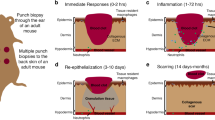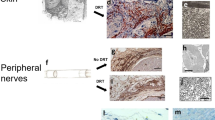Abstract
Skin wounds in young embryos heal rapidly, efficiently and perfectly without scar formation, an ability that is lost as development proceeds. The tissue movements of repair (re-epithelialisation and connective tissue contraction) are the same in embryos as adults, but the means by which these movements are achieved are very different. Whilst adult wound front epidermal cells crawl forwards over the exposed substratum to close a defect, a gap in the embryonic epidermis is closed by contraction of a rapidly assembled actin purse-string. In the adult wound situation connective tissue contraction is brought about by specialist contractile myofibroblasts, but in the embryo standard embryonic fibroblasts exert similar tractional forces to bring the wound margins together. We review what is known of the cellular sources and the levels of various growth factor signals that might activate wound closure movements during embryonic and adult repair and how this knowledge might help in designing therapeutic strategies to enhance adult healing. Finally we discuss how studies of the tissue movements of embryonic wound healing may guide our understanding of more natural tissue movements that occur during embryogenesis, such as gastrulation and neurulation.
Similar content being viewed by others
Author information
Authors and Affiliations
Additional information
Accepted: 11 October 1996
Rights and permissions
About this article
Cite this article
Nodder, S., Martin, P. Wound healing in embryos: a review. Anat Embryol 195, 215–228 (1997). https://doi.org/10.1007/s004290050041
Issue Date:
DOI: https://doi.org/10.1007/s004290050041




